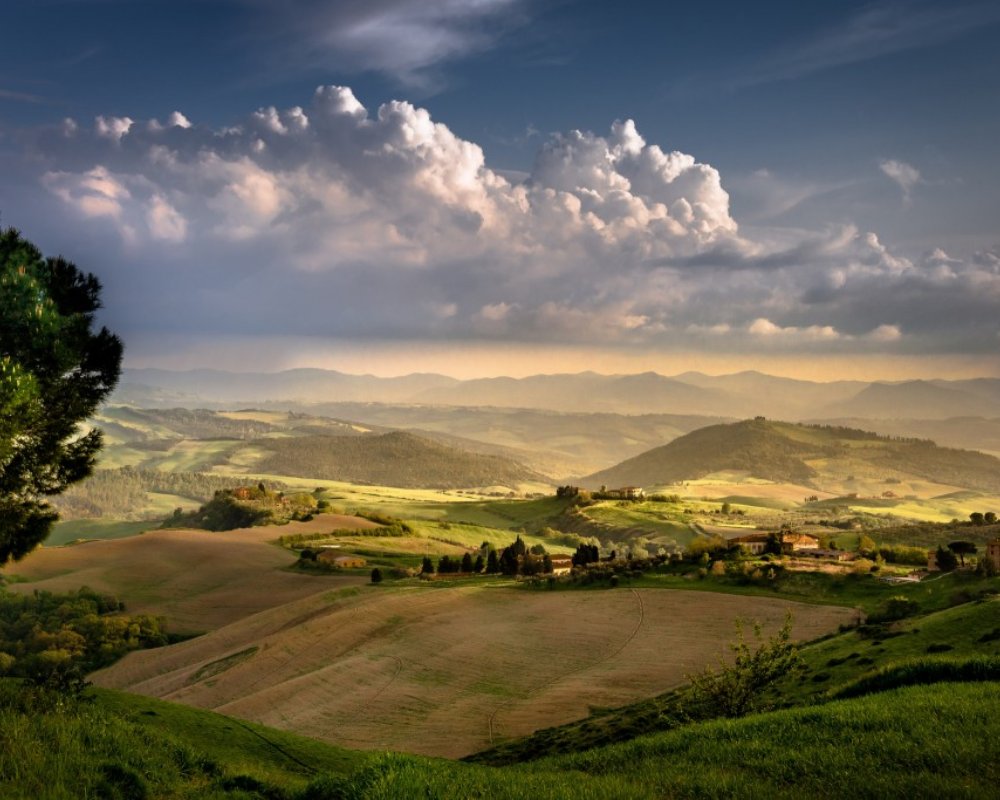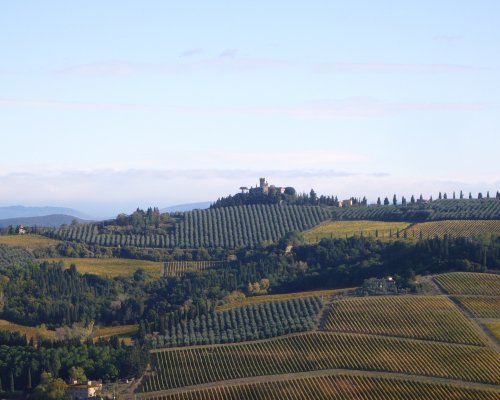A trip through nature and beauty from Florence to Volterra
In this landscape shaped by human history, we find wonderful examples of the harmony between geology, geomorphology, agriculture, forests and architecture. We take you along the Via Volterrana (also known as Via del Sale), a passage that was used for exchanging goods, ideas and cultures.
As soon as one leaves Florence, along the via Senese, there's the majestic Certosa di Firenze. A monastery complex built in 1341, with a fortress-like façade it still guards within it important masterpieces like works by Pontormo, and terracotta and majolica works by the Della Robbia family.
The Via Volterrana , with the Via Francigena, is one of the oldest roads in Tuscany, going from Florence through the hills of the Val di Pesa and the Valdelsa for more than 60 km before reaching Volterra.
Along this road you'll find Montespertoli, an important wine market, Castelfiorentino, Montaione and Gambassi Terme, a small town with a spectacular view of the surrounding hills.
As soon as one leaves Florence, along the via Senese, there's the majestic Certosa di Firenze. A monastery complex built in 1341, with a fortress-like façade it still guards within it important masterpieces like works by Pontormo, and terracotta and majolica works by the Della Robbia family.
The Via Volterrana , with the Via Francigena, is one of the oldest roads in Tuscany, going from Florence through the hills of the Val di Pesa and the Valdelsa for more than 60 km before reaching Volterra.
Along this road you'll find Montespertoli, an important wine market, Castelfiorentino, Montaione and Gambassi Terme, a small town with a spectacular view of the surrounding hills.
Here, the Val d’Elsa goes towards Certaldo, where Boccaccio was born, and where a special type of sweet onion comes from. A small medieval town, rich in charm and cultural events, its majestic Palazzo Pretorio has been the seat of Justice for the Val d’Elsa and the Val di Pesa for centuries.
From here, you can proceed on your journey to Siena, crossing the Via Francigena. The village of Monteriggioni dominates this part of the Siena countryside as it boasts rare examples of very well-preserved medieval architecture, a splendid city wall and 14 towers.
Here, the Val d’Elsa goes towards Certaldo, where Boccaccio was born, and where a special type of sweet onion comes from. A small medieval town, rich in charm and cultural events, its majestic Palazzo Pretorio has been the seat of Justice for the Val d’Elsa and the Val di Pesa for centuries.
From here, you can proceed on your journey to Siena, crossing the Via Francigena. The village of Monteriggioni dominates this part of the Siena countryside as it boasts rare examples of very well-preserved medieval architecture, a splendid city wall and 14 towers.
San Gimignano's historical centre is UNESCO World Heritage and an extraordinary example of a medieval city, where art, architecture and history come together to create an elegant town full of art dating from the XIV to the XV century. The city is famous for its towers, of which there were more than 70 in the Middle Ages. They could only be built by rich aristocratic families who could afford at least one ship anchored in Pisa’s harbour.
A small commercial town, San Gimignano has its economic roots in saffron, an exquisite spice that grew in the Val d’Elsa. Other products which historically supplied its welfare are: woollen fabrics, oil, wine (particularly Vernaccia, the first Italian wine to win the DOC warranty in 1966), which can be tasted along the strada della Vernaccia di San Gimignano, along with many other local excellent products.
San Gimignano's historical centre is UNESCO World Heritage and an extraordinary example of a medieval city, where art, architecture and history come together to create an elegant town full of art dating from the XIV to the XV century. The city is famous for its towers, of which there were more than 70 in the Middle Ages. They could only be built by rich aristocratic families who could afford at least one ship anchored in Pisa’s harbour.
A small commercial town, San Gimignano has its economic roots in saffron, an exquisite spice that grew in the Val d’Elsa. Other products which historically supplied its welfare are: woollen fabrics, oil, wine (particularly Vernaccia, the first Italian wine to win the DOC warranty in 1966), which can be tasted along the strada della Vernaccia di San Gimignano, along with many other local excellent products.
Volterra is on top of a hill in the valley where two rivers, Cecina and Era, meet in one of the most spectacular landscapes. Its fortune, in ancient times, was determined by the presence of mineral deposits in the nearby hills as it was rich in silver, lead and salt mines. Volterra was part of the 12 Etruscan lucumonies and has a medieval town layout, the core of which is Piazza dei Priori. The ancient walls are perfectly maintained and they only partly trace the line of the Etruscan ones.
You have to to visit the Duomo, the Baptistery and the Museo Etrusco Guarnacci, which has a collection of archaeological ruins as well as roman ones, and more than 600 cinerary urns in tuff, alabaster and terracotta, coming from several different necropolis. Important evidence of the past can also be found in the archaeological area of Vallebuona where you'll find the ruins of a theatre and some hot springs and as well as the Archaeological Park area, where the ruins of the Etruscan-Roman acropolis are.
Volterra is on top of a hill in the valley where two rivers, Cecina and Era, meet in one of the most spectacular landscapes. Its fortune, in ancient times, was determined by the presence of mineral deposits in the nearby hills as it was rich in silver, lead and salt mines. Volterra was part of the 12 Etruscan lucumonies and has a medieval town layout, the core of which is Piazza dei Priori. The ancient walls are perfectly maintained and they only partly trace the line of the Etruscan ones.
You have to to visit the Duomo, the Baptistery and the Museo Etrusco Guarnacci, which has a collection of archaeological ruins as well as roman ones, and more than 600 cinerary urns in tuff, alabaster and terracotta, coming from several different necropolis. Important evidence of the past can also be found in the archaeological area of Vallebuona where you'll find the ruins of a theatre and some hot springs and as well as the Archaeological Park area, where the ruins of the Etruscan-Roman acropolis are.
From Volterra to Larderello, you'll notice the geological characteristics of the soil and the subsoil throughout this beautiful and unique landscape. Going from the Balze of Volterra, you'll see the visible superimposition of sandstones on layers of clay before moving towards the Colline Metallifere where the mineralogical nature of the earth reveals itself through wonderful colourful variations in the geology.
Along Route 68, erosion of the Biancane is visible and is of a greyish-blue colour. From Saline di Volterra, the road heads to Pomarance, where it meets Valle del Diavolo , named after the steam that came from under the soil. Today, this geothermic activity is used for energy production in Larderello. Here, the Museum of Geothermic Sciences is one of the several museums composing the museum networks of the Rete Museale della Val di Cecina.
The Lagoni, small pools of boiling mud and water, were also used in Etruscan and Roman times and as well as in 1818 by Earl Larderel for the extraction of boric acid on an industrial scale. The fumaroles of gas and steam are used for the production of electrical energy, while the hot springs are used for its therapeutic effects.
From Volterra to Larderello, you'll notice the geological characteristics of the soil and the subsoil throughout this beautiful and unique landscape. Going from the Balze of Volterra, you'll see the visible superimposition of sandstones on layers of clay before moving towards the Colline Metallifere where the mineralogical nature of the earth reveals itself through wonderful colourful variations in the geology.
Along Route 68, erosion of the Biancane is visible and is of a greyish-blue colour. From Saline di Volterra, the road heads to Pomarance, where it meets Valle del Diavolo , named after the steam that came from under the soil. Today, this geothermic activity is used for energy production in Larderello. Here, the Museum of Geothermic Sciences is one of the several museums composing the museum networks of the Rete Museale della Val di Cecina.
The Lagoni, small pools of boiling mud and water, were also used in Etruscan and Roman times and as well as in 1818 by Earl Larderel for the extraction of boric acid on an industrial scale. The fumaroles of gas and steam are used for the production of electrical energy, while the hot springs are used for its therapeutic effects.


